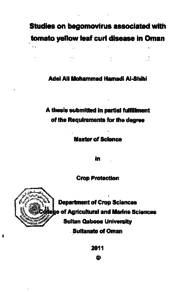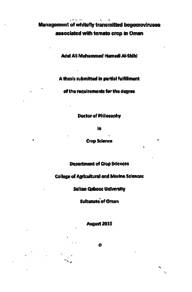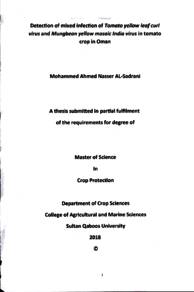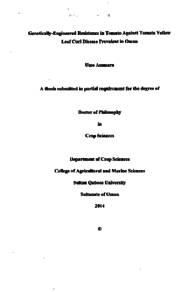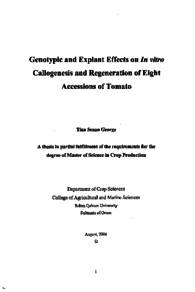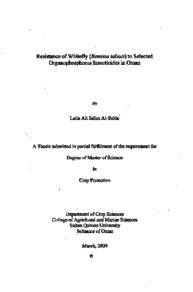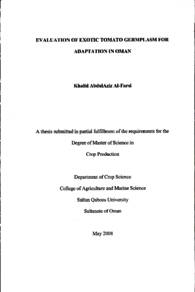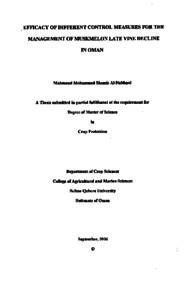وثيقة
Studies on begomorius associated wth tomato yellow leaf curl disease in Oman
الناشر
Sultan Qaboos University
ميلادي
2011
اللغة
الأنجليزية
الملخص الإنجليزي
tomato yellow leaf curl virus is a member in begomovirus genus which transmitted by whitefly (Bemisia tabaci). It has a main role in causing great economic losses for the tomato crops all over the world. The disease incidence was recorded as high as 100% in non protected fields while it was less than 10% in Agryl protected fields. Typical symptoms of this disease represented in the yellowing, upward curling of the leaves and severe stunting of the whole plant. Total nucleic acid isolated from whitefly genders was used as template to amplify the core coat protein (CP) and satellite DNA (DNA-B) by using polymerase chain reaction (PCR). Two Primer pairs used FD-CP382/RD-CP1038 and SATO1/SATO2 for CP and DNA-B, respectively. The PCR amplification yielded, 12 positive samples for the CP out of 18 and 3 positive samples out of 18 for the DNA-B of the sizes 650pb and 1350pb, respectively. The female whitefly has more efficiency in transmitting the TYLCV than male whitefly and the DNA-B can be transmitted from one plant to another by whitefly. The minimum viral acquisition and transmission rates by whitefly were evaluated by using PCR and recording symptoms visually, which were 30 min and 15 min, respectively. The Agryl cover was used in the field experiment to evaluate the optimum period for covering the tomato plants against whitefly. The period of 8 weeks covering with Agryl cover approved to be the best period for getting the best yield and protection. TYLCV transmitting whiteflies were used to screen 17 inbred-lines to see their susceptibility toward TYLCV. Nine out of seventeen inbred-lines were found resistant whereas eight of them showed moderate to a high susceptibility to TYLCV. Amplification fragment length polymorphism (AFLP) was done by using six primer combinations which as follow: (E- AAC/ MCAG), (E- AAC/ M-CAC), (E- ACA/ M-CT), (E- AGG/ M-CTT), (E- AGG/MCAA) and (E- AGG/ M-CAG). It revealed a high polymorphism among inbredlines, AFLP analysis showed a clustering among some of the resistant inbred-lines and also for high susceptible inbred-lines by using dendrogram. The clustering indicates to the genetic relationship among these inbred-lines. This can contribute to make some decisions by breeders in relation to the choice of the appropriate parents and linkage for the resistance genes.
المجموعة
URL المصدر
الملخص العربي
ينتمي فيروس تجعد واصفرار أوراق الطماطم إلى الجنس Begomovirus وينتقل عن طريق الذبابة البيضاء (Bemisia tabaci). هذا الفيروس له دور رئيسي في التسبب في خسائر اقتصادية كبيرة لمحصول الطماطم في جميع أنحاء العالم حيث تصل نسبة الإصابة إلى 100 ٪ في الحقول الغير محمية في حين تسجل نسبة الإصابة بأقل من 10 % في الحقول المحمية بغطاء الاجريل. تتمثل أعراض المرض في اصفرار وتجعد أوراق الطماطم و نقص في مساحة الأوراق والتقزم الشديد للنبات بشكل كامل إذا حدثت الإصابة في مراحل النمو المبكرة للنبات. تم استخدام الحمض النووي الكامل المعزول من الجنسين للذبابة البيضاء كقالب لتضخيم بؤرة الغطاء البروتيني الأساسية والحمض النووي المصاحب لمعظم سلالات هذا الفيروس (DNA-B ) باستخدام تفاعل السلسلة المتبلورة. وقد استخدمت البادئة FD - CP382 / RD -CP1038 و SAT01 / SAT02 لبؤرة الغطاء البروتيني والحمض النووي ، على التوالي. وأسفرت النتائج عن تضخيم 12 عينة لبؤرة الغطاء البروتيني و 3 عينات إيجابية من أصل 18 للحمض النووي 8 ذات الأحجام pb650 وpb1350، على التوالي. وجد أن أنثى الذبابة البيضاء أكثر كفاءة في نقل هذا الفيروس من الذكر والحمض النووي لا يمكن أن ينتقل من نبات لأخر عن طريق الذبابة البيضاء بالتصاحب مع الفيروس الرئيسي. ايضا تم تحديد الحد الأدنى من معدلات اكتساب و انتقال الفيروس إلى نباتات الطماطم السليمة عن طريق الذبابة البيضاء وقد تبين بعد استخدام تفاعل السلسلة المتبلورة والأعراض التي سجلت بان اقل وقت لاكتساب ونقل الفيروس بواسطة الحشرة البيضاء هو 30 دقيقة و 15 دقيقة، على التوالي. كما تم استخدام غطاء الاجريل في الحقل على فترات مختلفة لتغطية نبات الطماطم وذلك لتحديد أفضل الفترات الملائمة التغطية نبات الطماطم ضد الذبابة البيضاء وقد أثبتت النتائج أن تغطية المحصول الفترة 8 أسابيع بالاجريل كانت أفضل فترة للحصول على أفضل مردود بالإضافة للحماية الجيدة ضد هذا الفيروس. وفي تجربة أخرى استخدمت الذبابة البيضاء لنقل فيروس تجعد واصفرار اوراق الطماطم إلى 17 صنف من أصناف الطماطم لمعرفة مدى حساسية هذه الأصناف ضد هذا الفيروس وقد تم التوصل إلى أن 9 أصناف من أصل 17 صنف من الطماطم قد وجد مقاومة لهذا الفيروس في حين أظهرت 8 من هذه الأصناف إصابات مابين المتوسطة إلى العالية تجاه هذا الفيروس. وقد أظهرت التحاليل المختبرية والتي أجريت بواسطة طريقة تباین طول قطع الحمض النووي المكبرة باستخدام 6 ازواج من البواديء وهذه الأزواج كالتالي (E - AAC / M - CAG)،،(E- AGG/ M- CAA) (E AGG/ M- CTT)، (E ACA/ M- CTC) ،(E- AAC/ M- CAC)(E AGG/ M - CAG ) على وجود علاقة وراثية بين بعض الأصناف من حيث حساسيتها لهذا المرض، حيث أتت بعض من الأصناف المقاومة لهذا المرض متجمعة مع بعضها وأيضا بالمثل للأصناف العالية الحساسية أتت متجمعة مع بعضها والذي يدل على وجود علاقة جينية تربط تلك الأصناف مع بعضها البعض. من الممكن أن تساعد مثل هذه التجارب الباحثين في انتقاء أفضل الأمهات وكذلك تحديد وجود الجينات المقاومة لهذا المرض.
قالب العنصر
الرسائل والأطروحات الجامعية

